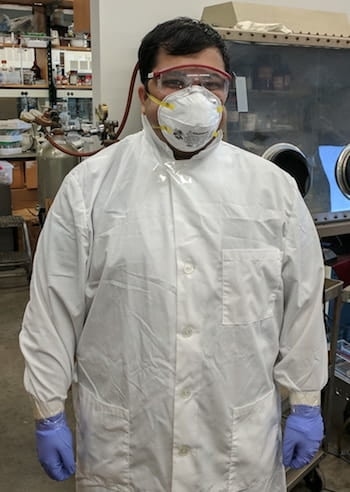Jun 4 2019
With some practice, it would take just about 10 minutes, few bags, and a big bucket to maintain nanomaterials in their place.
 Varun Shenoy Gangoli, a research scientist at Rice University, models the proper attire for handling bulk nanomaterials for laboratory use. (Courtesy of the Barron Research Group)
Varun Shenoy Gangoli, a research scientist at Rice University, models the proper attire for handling bulk nanomaterials for laboratory use. (Courtesy of the Barron Research Group)
Chemist Andrew Barron from the Rice University lab works with bulk carbon nanotubes on a number of projects. Some years back, members of the lab became anxious that nanotubes could escape into the air, and formulated an economical and clean technique to ensure they stay contained as they were shifted from large containers into jars for experimental use.
Of late Barron himself became concerned that very few labs worldwide were using best practices to work with nanomaterials. He decided to publicize the insights gained by him and his Rice team.
There was a series of studies that said if you’re going to handle nanotubes, you really need to use safety protocols. Then I saw a study that said many labs didn’t use any form of hood or containment system. In the U.S., it was really bad, and in Asia it was even worse. But there are a significant number of labs scaling up to use these materials at the kilogram scale without taking the proper precautions.
Andrew Barron, Chemist, Rice University Lab
The lab’s low-cost technique is explained in full in an open-access paper in the Springer Nature journal SN Applied Sciences.
Carbon nanotubes, in bulk form, are fluffy and scatter easily if disturbed. The Rice lab usually stores the tubes in 5-gallon plastic buckets, and merely opening the lid is sufficient to cause them to fly due to their low density.
Varun Shenoy Gangoli, a research scientist in Barron’s lab, and Pavan Raja, a scientist with Rice’s Nanotechnology-Enabled Water Treatment center, formulated for their own use a technique that involves safeguarding the worker and sequestering loose tubes when removing smaller volumes of the material for experimental use.
Complete details are presented in the paper, but the safety aspects include ensuring workers are correctly attired with long sleeves, long pants, full goggles, lab coats, and face masks, together with two pairs of gloves duct-taped to the lab coat sleeves. The improvised glove bag comprises of a 25-gallon trash bin with a plastic bag taped to the rim. The unopened storage container is positioned inside, and then the bin is covered with another transparent trash bag, with tiny holes cut in the top for access.
After shifting the nanotubes, the gloves are cleaned with acetone wipes. More acetone is then sprayed inside the barrel so settling nanotubes would adhere to the surfaces. From here, they can be recovered and returned to the storage container.
Barron said lab members took time to learn to use the protocol properly, “but now they can get their samples in 5 to 10 minutes.” He is sure other labs can and will improve the method for their own environments. He noted a poster by Gangoli shown at the Ninth Guadalupe Workshop on the right handling of carbon nanotubes garnered recognition and discussion among the world’s premier scientists in the field, noting the significance of the work for agencies on the whole.
When we decided to write about this, we were originally just going to put it on the web and hope somebody would read it occasionally. We couldn’t imagine who would publish it, but we heard that an editor at Springer Nature was really keen to have published articles like this. I think this is something people will use. There’s nothing outrageous but it helps everybody, from high schools and colleges that are starting to use nanoparticles for experiments to small companies. That was the goal: Let’s provide a process that doesn’t cost thousands of dollars to install and allows you to transfer nanomaterials safely and on a large scale. Finally, publish said work in an open-access journal to maximize the reach across the globe.
Andrew Barron, Chemist, Rice University Lab
Gibran Liezer Esquenazi, an alumnus of the Barron group at Rice, is a co-author on the paper. Barron is a professor emeritus of chemistry at Rice and the Sêr Cymru Chair of Low Carbon Energy and Environment at Swansea University, Wales.
The research received funding via the Robert A. Welch Foundation, the Office of Naval Research, and the Welsh government through the Sêr Cymru Chair Program.